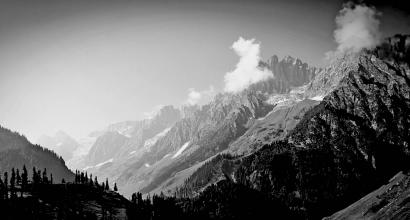ಕವಿ-ಕಾವ್ಯ
ನಾನೃಷಿಃ ಕವಿರಿತ್ಯುಕ್ತಮೃಷಿಶ್ಚ ಕಿಲ ದರ್ಶನಾತ್ |
ವಿಚಿತ್ರಭಾವಧರ್ಮಾಂಶತತ್ತ್ವಪ್ರಖ್ಯಾ ಚ ದರ್ಶನಮ್ ||
ಸ ತತ್ತ್ವದರ್ಶನಾದೇವ ಶಾಸ್ತ್ರೇಷು ಪಠಿತಃ ಕವಿಃ |
ದರ್ಶನಾದ್ವರ್ಣನಾಚ್ಚಾಥ ರೂಢಾ ಲೋಕೇ ಕವಿಶ್ರುತಿಃ ||
ತಥಾ ಹಿ ದರ್ಶನೇ ಸ್ವಚ್ಛೇ ನಿತ್ಯೇಽಪ್ಯಾದಿಕವೇರ್ಮುನೇಃ |
ನೋದಿತಾ ಕವಿತಾ ಲೋಕೇ ಯಾವಜ್ಜಾತಾ ನ ವರ್ಣನಾ || (ಕಾವ್ಯಾನುಶಾಸನ, ಪು. ೪೩೨)
ಋಷಿಯಲ್ಲದವನು ಕವಿಯಲ್ಲ. ಋಷಿತ್ವ ಬರುವುದು ದರ್ಶನದಿಂದ. ಚಿತ್ರ-ವಿಚಿತ್ರವಾದ, ಬಗೆಬಗೆಯ ಭಾವಾಸ್ತಿತ್ವಗಳ ತಾತ್ತ್ವಿಕ ಸಮನ್ವಯವೇ ದರ್ಶನ. ಶಾಸ್ತ್ರಗಳು ಇಂಥ ದರ್ಶನವುಳ್ಳವನನ್ನೇ ಕವಿಯೆಂದು ಪರಿಗಣಿಸುತ್ತವೆ. ಆದರೆ ಜಗತ್ತು ದರ್ಶನ ಮತ್ತು ವರ್ಣನೆಗಳೆರಡನ್ನೂ ಮೈಗೂಡಿಸಿಕೊಂಡವನನ್ನೇ ಕವಿಯೆಂದು ಗುರುತಿಸುತ್ತದೆ. ಆದಿಕವಿ ವಾಲ್ಮೀಕಿ ಮಹರ್ಷಿಗಳಿಗೆ ಮೊದಲಿನಿಂದಲೂ ನಿರ್ಮಲವಾದ ದರ್ಶನವಿದ್ದಿತು. ಆದರೆ ಅವರ ದರ್ಶನವು ವರ್ಣನೆಯ ರೂಪದಲ್ಲಿ ಹೊಮ್ಮದವರೆಗೂ ಕವಿತೆಯು ಲೋಕದಲ್ಲಿ ಕಾಣಿಸಿಕೊಳ್ಳಲಿಲ್ಲ.
ಭಟ್ಟತೌತನ ಈ ಮಾತುಗಳಿಗೆ ತುಂಬ ಬೆಲೆಯಿದೆ. ‘ಋಷಿರ್ದರ್ಶನಾತ್’ ಎಂಬ ಒಕ್ಕಣೆ ಯಾಸ್ಕರ ನಿರುಕ್ತದಲ್ಲಿ (೨.೩.೨) ಕಂಡುಬರುತ್ತದೆ. ವೇದ-ಉಪನಿಷತ್ತುಗಳಲ್ಲಿ ಋಷಿ ಅಥವಾ ಜ್ಞಾನಿ ಎಂಬ ಶಬ್ದಗಳಿಗೆ ಪರ್ಯಾಯವಾಗಿ ಕವಿಶಬ್ದವು ವ್ಯಾಪಕವಾಗಿ ಬಳಕೆಯಾಗಿದೆ. ಋಕ್ಸಂಹಿತೆಯೊಂದರಲ್ಲಿಯೇ ನೂರಾರು ಬಾರಿ ಈ ಶಬ್ದ ಬಂದಿದೆ (೪.೨೬.೧). ಈ ಆಶಯವನ್ನು ಈಶಾವಾಸ್ಯೋಪನಿಷತ್ತು ಮತ್ತೂ ಸ್ಪಷ್ಟವಾಗಿ ಒಕ್ಕಣಿಸಿದೆ (೮). ಇವೆಲ್ಲವನ್ನೂ ಬೆಸೆದು ಕವಿ-ಕಾವ್ಯಗಳನ್ನು ಲಕ್ಷಣೀಕರಿಸಿದ ಶ್ರೇಯಸ್ಸು ತೌತನದು. ಇದಕ್ಕೆ ಆತನು ರಾಮಾಯಣದ ಆವಿರ್ಭಾವವನ್ನು ಆಶ್ರಯಿಸಿದುದು ಯುಕ್ತವಾಗಿದೆ. ಆನಂದವರ್ಧನ ಮತ್ತು ರಾಜಶೇಖರರು ರಾಮಾಯಣದ ಆವಿರ್ಭಾವವನ್ನು ಕಟಾಕ್ಷಿಸಿರುವುದು (ಧ್ವನ್ಯಾಲೋಕ, ೧.೫; ಕಾವ್ಯಮೀಮಾಂಸೆ, ಪು. ೭) ಭಟ್ಟತೌತನಿಗೆ ಸ್ಫೂರ್ತಿಯಾಗಿದೆ ಎನ್ನಬಹುದು.
* * *
ಸ್ಮೃತಿರ್ವ್ಯತೀತವಿಷಯಾ ಮತಿರಾಗಾಮಿಗೋಚರಾ |
ಬುದ್ಧಿಸ್ತಾತ್ಕಾಲಿಕೀ ಜ್ಞೇಯಾ ಪ್ರಜ್ಞಾ ತ್ರೈಕಾಲಿಕೀ ಮತಾ || (ಸಂಪ್ರದಾಯಪ್ರಕಾಶಿನೀ, ಪು. ೧೩)
ಪ್ರಜ್ಞಾ ನವನವೋಲ್ಲೇಖಶಾಲಿನೀ[1] ಪ್ರತಿಭಾ ಮತಾ |
ತದನುಪ್ರಾಣನಾಜೀವದ್ವರ್ಣನಾನಿಪುಣಃ ಕವಿಃ |
ತಸ್ಯ ಕರ್ಮ ಸ್ಮೃತಂ ಕಾವ್ಯಮ್ || (ಕಾವ್ಯಾನುಶಾಸನ, ಪು. ೩)
ನೆನಪು ಆಗಿಹೋದ ಸಂಗತಿಗಳಿಗೆ ಸಂಬಂಧಿಸಿದೆ. ಮತಿಯು ಬರಲಿರುವ ವಿಷಯಗಳನ್ನು ಕುರಿತಿರುತ್ತದೆ. ಬುದ್ಧಿಯು ವರ್ತಮಾನಕ್ಕೆ ಅಂಟಿಕೊಂಡಿದೆ. ಪ್ರಜ್ಞೆಯಾದರೋ ಮೂರು ಕಾಲಗಳಲ್ಲಿಯೂ ವ್ಯಾಪಿಸಿದೆ. ಇಂಥ ಪ್ರಜ್ಞೆಯು ಹೊಸ ಹೊಸ ಹೊಳಹುಗಳನ್ನು ಹೊಂದಿದಾಗ (ಹೊಸ ಹೊಸ ಅಭಿವ್ಯಕ್ತಿಗಳನ್ನು ತಳೆದಾಗ) ಪ್ರತಿಭೆ ಎನಿಸಿಕೊಳ್ಳುತ್ತದೆ. ಈ ಬಗೆಯ ಪ್ರತಿಭೆಯಿಂದ ಪರಿಪುಷ್ಟವಾದ, ಜೀವಕಾಂತಿಯಿಂದ ನಳನಳಿಸುವ ವರ್ಣನೆಯನ್ನು ಮಾಡಬಲ್ಲ ನಿಪುಣನೇ ಕವಿ. ಅವನ ಇಂಥ ಕೆಲಸವೇ ಕಾವ್ಯವೆನಿಸಿಕೊಳ್ಳುತ್ತದೆ.
ಭಟ್ಟತೌತನ ಈ ಮಾತುಗಳು ಅಚ್ಚಳಿಯದ ಒಳನೋಟಗಳಿಂದ ಕೂಡಿದ್ದು ಕಲಾಜಗತ್ತಿನಲ್ಲಿಯೇ ಅನನ್ಯವೆನಿಸಿವೆ. ಇಲ್ಲಿ ಕಲಾಸಾಮಾನ್ಯದ ಮೂಲಧಾತುವಾದ ಪ್ರತಿಭೆಯನ್ನು ಕೇಂದ್ರದಲ್ಲಿರಿಸಿಕೊಂಡು ಅದರ ಹಿನ್ನೆಲೆಯಲ್ಲಿ ದುಡಿಯುವ ಸ್ಮೃತಿ, ಮತಿ, ಬುದ್ಧಿ ಮತ್ತು ಪ್ರಜ್ಞೆಗಳನ್ನೂ ಮುನ್ನೆಲೆಯಲ್ಲಿ ಕಾಣಿಸಿಕೊಳ್ಳುವ ಕವಿ ಮತ್ತು ಕಾವ್ಯಗಳನ್ನೂ ಸಾರವತ್ತಾಗಿ ಲಕ್ಷಣೀಕರಿಸಲಾಗಿದೆ. ಹಿಂದಿನ ಉಲ್ಲೇಖದಲ್ಲಿ ಎದ್ದುಕಾಣುವ ದರ್ಶನ ಮತ್ತು ಇಲ್ಲಿ ಒಕ್ಕಣೆಗೊಂಡ ಪ್ರತಿಭೆ ಬಲುಮಟ್ಟಿಗೆ ಒಂದೇ ಆದರೂ ಅವುಗಳ ನಡುವೆ ಸೂಕ್ಷ್ಮ ವ್ಯತ್ಯಾಸವಿದೆ - ದರ್ಶನವು ‘ವಿಚಿತ್ರಭಾವಧರ್ಮಾಂಶತತ್ತ್ವಪ್ರಖ್ಯೆ’ ಆದರೆ ಪ್ರತಿಭೆಯು ‘ನವನವೋಲ್ಲೇಖಶಾಲಿನಿ’ / ‘ನವನವೋನ್ಮೇಷಶಾಲಿನಿ’. ಅಂದರೆ, ದರ್ಶನದಲ್ಲಿ ನಾನಾ ಭಾವಧರ್ಮಾಂಶಗಳ ತತ್ತ್ವಸಮನ್ವಯ - ಅರ್ಥಾತ್, ಅಖಂಡಾನುಭವ - ಇದ್ದರೆ, ಪ್ರತಿಭೆಯಲ್ಲಿ ಇಂಥ ಅನುಭವವನ್ನು ಹೊಸಹೊಸತಾಗಿ ಕಾಣಿಸಬಲ್ಲ, ಒಕ್ಕಣಿಸಬಲ್ಲ ತ್ರಿಕಾಲವ್ಯಾಪ್ತ ಪ್ರಜ್ಞೆಯಿದೆ. ಒಂದು ತನ್ಮಯತೆಯಾದರೆ ಮತ್ತೊಂದು ತಜ್ಜಾಗೃತಿ. ಮತ್ತೂ ಸ್ಪಷ್ಟಪಡಿಸುವುದಾದರೆ, ಒಂದು ಜ್ಞಾನ-ವಿಜ್ಞಾನಗಳ ನೆಲೆ; ಮತ್ತೊಂದು ಕರ್ಮ-ಕಥನಗಳ ನೆಲೆ. ಮೊದಲನೆಯದರಲ್ಲಿ ಸ್ವತಃಪರ್ಯಾಪ್ತಿಯ ಮೌನವಿದ್ದರೆ, ಎರಡನೆಯದರಲ್ಲಿ ಸ್ವತಃಸಂತೋಷದ ಸಂವಿಭಾಗವಿದೆ. ದರ್ಶನವು ಆತ್ಮಾರಾಮತೆಯ ಆನಂದದಲ್ಲಿ ಕೊನೆಗೊಂಡರೆ, ಪ್ರತಿಭೆಯು ಇಂಥ ಆನಂದವನ್ನು ಅಂದವಾಗಿ, ಅವ್ಯಾಜವಾಗಿ ಹಂಚಿಕೊಳ್ಳಬೇಕೆಂಬ ಅಕ್ಕರೆಯನ್ನು ಒಳಗೊಂಡಿದೆ. ದಿಟ, ಪ್ರತಿಭೆಯಿಲ್ಲದವರೂ ಕಲೆಗೆ ಕೈಹಾಕುವುದುಂಟು; ಬರೆವಣಿಗೆಗೆ ಮುಂದಾಗುವುದುಂಟು. ಆದರೆ ಇದನ್ನು ಭಟ್ಟತೌತ ಆದರಿಸುವುದಿಲ್ಲ. ಆತನ ಪ್ರಕಾರ ವರ್ಣನೆಗೆ ಜೀವಂತಿಕೆ ಬಂದರೆ ಅಲ್ಲಿ ಪ್ರತಿಭೆಯ ಪಾರಮ್ಯ ಇರುತ್ತದೆ. ಜೀವವಿಲ್ಲದ ವರ್ಣನೆ ಕಲಾಭಾಸ, ಕಾವ್ಯಾಭಾಸ. ಇಲ್ಲಿ ಜೀವದ್ವರ್ಣನೆ ಎಂದರೆ ವಿಭಾವ-ಅನುಭಾವಗಳ ಔಚಿತ್ಯಪೂರ್ಣವಾದ ಆಕರ್ಷಕ ನಿರೂಪಣೆ. ಈ ವಿವರಣೆಯನ್ನು ಮುಂದೆ ಭಟ್ಟತೌತನ ಮಾತುಗಳಲ್ಲಿಯೇ ಕಾಣುತ್ತೇವೆ. ಹೀಗೆ ತೌತ ಹೇಳುವ ಜೀವದ್ವರ್ಣನೆ ಭರತಮುನಿಯ ರಸಸೂತ್ರಕ್ಕೆ[2] ಪೂರಕವಾಗಿ ಬರುತ್ತದೆ.
ಸ್ಮೃತಿ, ಮತಿ, ಬುದ್ಧಿ, ಪ್ರಜ್ಞೆ ಮುಂತಾದ ತತ್ತ್ವಗಳು ದರ್ಶನಶಾಸ್ತ್ರಗಳಲ್ಲಿ ಮೊದಲಿನಿಂದ ಬಳಕೆಗೊಂಡಿದ್ದುವಾದರೂ ಅವನ್ನು ಕಾವ್ಯಮೀಮಾಂಸೆಗೆ ಸಮರ್ಥವಾಗಿ ಹವಣಿಸಿಕೊಟ್ಟ ಶ್ರೇಯಸ್ಸು ತೌತನಿಗೆ ಸಲ್ಲುತ್ತದೆ. ಭಗವದ್ಗೀತೆಯು ಸ್ಮೃತಿ, ಧೃತಿ, ಮೇಧೆ ಮುಂತಾದುವನ್ನು ಭಗವಂತನ ವಿಭೂತಿಗಳೆಂದು ಹೇಳಿದೆ (೧೦.೩೪). ನಾಟ್ಯಶಾಸ್ತ್ರ ಈ ಸಾಲಿಗೆ ಮತಿ ಮುಂತಾದುವನ್ನೂ ಸೇರಿಸಿ ಕಲೆಗೆ ಸಿದ್ಧಿಯನ್ನು ನೀಡುವ ಅಂಶಗಳು ಇವೇ ಎಂದು ಒಕ್ಕಣಿಸಿದೆ (೩.೮೭). ಭಟ್ಟತೌತನ ಪೂರ್ವಸೂರಿಗಳಾದ ಭಾಮಹ, ದಂಡಿ, ವಾಮನ ಮೊದಲಾದವರು ಕಲೆಗೆ ಮೂಲಪ್ರೇರಣೆ ಪ್ರತಿಭೆಯೆಂದೇ ಸಾರಿದ್ದಾರೆ.[3] ತೌತನ ನಿಕಟ ಪೂರ್ವವರ್ತಿಯೋ ಸಮಸಾಮಯಿಕನೋ ಎನ್ನಬಹುದಾದ ರಾಜಶೇಖರ ಈ ನಿಟ್ಟಿನಲ್ಲಿ ಮತ್ತಷ್ಟು ಮುಂದುವರಿದಿರುವುದು ಇಲ್ಲಿ ಉಲ್ಲೇಖನೀಯ. ಅವನ ಪ್ರಕಾರ - ಬುದ್ಧಿಯು ಸ್ಮೃತಿ, ಮತಿ ಮತ್ತು ಪ್ರಜ್ಞೆ ಎಂದು ಮುಬ್ಬಗೆಯಾಗಿದೆ; ಭೂತವನ್ನು ನೆನೆಯುವುದು ಸ್ಮೃತಿ, ವರ್ತಮಾನವನ್ನು ಅರಿಯುವುದು ಮತಿ, ಭವಿಷ್ಯವನ್ನು ತಿಳಿಯಬಲ್ಲುದು ಪ್ರಜ್ಞೆ.[4] ಇಲ್ಲಿ ಭಟ್ಟತೌತನು ಹೇಳುವ ಅಂಶಗಳೇ ಬಂದಿದ್ದರೂ ಅವುಗಳ ವಿವರ ಬೇರೆಯಾಗಿದೆ. ತೌತನ ಪ್ರಕಾರ ಪ್ರಜ್ಞೆಯು ತ್ರೈಕಾಲಿಕ; ರಾಜಶೇಖರನ ಪ್ರಕಾರ ಈ ಸ್ಥಾನಕ್ಕೆ ಅರ್ಹವಾದುದು ಬುದ್ಧಿ. ಇವುಗಳ ಸಾಧುತ್ವ-ಅಸಾಧುತ್ವಗಳ ವಿವೇಚನೆ ಕಷ್ಟ. ಆದರೆ ಪರವರ್ತಿಗಳಾದ ಆಲಂಕಾರಿಕರೆಲ್ಲ ರಾಜಶೇಖರನನ್ನು ಅನುಸರಿಸದೆ ತೌತನನ್ನೇ ನೆಮ್ಮಿರುವುದನ್ನು ಕಂಡಾಗ ಇವನ ಕಾಣ್ಕೆಗೆ ಸಂಪ್ರದಾಯದ ಬಲವಿರುವುದು ತಿಳಿಯುತ್ತದೆ. ಅಲ್ಲದೆ ಪ್ರಜ್ಞಾ ಎಂಬ ಶಬ್ದದಲ್ಲಿರುವ ‘ಪ್ರ’ ಎಂಬ ಉಪಸರ್ಗ ತಿಳಿವಿನ ಹೆಚ್ಚಳವನ್ನು ಸೂಚಿಸುವ ಕಾರಣ ಇದೇ ತ್ರಿಕಾಲವರ್ತಿ ಎಂಬುದಕ್ಕೆ ಪುಷ್ಟಿ ಸಿಗುತ್ತದೆ.
ಕಾವ್ಯರಚನೆ
ಲಕ್ಷಣಾಲಂಕೃತಿಗುಣಾ ದೋಷಾಃ ಶಬ್ದಪ್ರವೃತ್ತಯಃ |
ವೃತ್ತಿಸಂಧ್ಯಂಗಸಂರಂಭಃ ಸಂಭಾರೋ ಯಃ ಕವೇಃ ಕಿಲ ||
ಅನ್ಯೋನ್ಯಸ್ಯಾನುಕೂಲ್ಯೇನ ಸಂಭೂಯೈವ ಸಮುತ್ಥಿತೈಃ |
ಝಟಿತ್ಯೇವ ರಸಾ ಯತ್ರ ವ್ಯಜ್ಯಂತೇ ಹ್ಲಾದಿಭಿರ್ಗುಣೈಃ (ಣಾಃ) ||
ವೃತ್ತೈಃ ಸರಲಬಂಧೈರ್ಯತ್ ಸ್ನಿಗ್ಧೈಶ್ಚೂರ್ಣಪದೈರಪಿ |
ಸು(ಅ)ಶ್ಲಿಷ್ಟಹೃದ್ಯಘಟನಂ ಭಾಷಯಾ ಸುಪ್ರಸಿದ್ಧಯಾ ||
ಯಚ್ಚೇದೃಕ್ಕಾವ್ಯಮಾತ್ರಂ ಸದ್ರಸಭಾವಾನುಭಾವಕಮ್ |
ಸಾಮಾನ್ಯಾಭಿನಯೇ ಪ್ರೋಕ್ತಂ ವಾಚ್ಯಾಭಿನಯಸಂಜ್ಞಯಾ ||
ಏವಂಪ್ರಕಾರಂ ಯತ್ಕಿಂಚಿದ್ವಸ್ತುಜಾತಂ ಕಥಾರ್ಪಿತಮ್ |
ಅನೂನಾಧಿಕಸಾಮಾಗ್ರೀಪರಿಣಾಮೋನ್ಮಿಷದ್ರಸಮ್ ||
ರಸಪೋಷಾಯ ತಜ್ಜಾತಂ ಲೋಕಾನ್ನಾಟ್ಯಜಗತ್ಸ್ವಯಮ್ |
ಪ್ರತಿಭಾಯಾಃ ಪ್ರಗಲ್ಭಾಯಾಃ ಸರ್ವಸ್ವಂ ಕವಿವೇಧಸಃ ||[5] (ಅಭಿನವಭಾರತೀ, ಸಂ. ೩, ಪು. ೭೫)
ಲಕ್ಷಣಗಳು, ಅಲಂಕಾರಗಳು, ಗುಣಗಳು, ದೋಷವಿವೇಕ, ಶಬ್ದವೃತ್ತಿಗಳು, ನಾಟ್ಯವೃತ್ತಿಗಳು, ಸಂಧಿ-ಸಂಧ್ಯಂಗಗಳೇ ಮೊದಲಾಗಿ ಕವಿಗಳಿಗೆ ಒದಗಿಬರುವ ಯಾವೆಲ್ಲ ಸಾಮಗ್ರಿಯುಂಟೋ ಅದನ್ನು ಪರಸ್ಪರ ಹೊಂದಿಸಿಕೊಂಡು ಒಟ್ಟಾಗಿ ದುಡಿಯುವಂತೆ ರೂಪಿಸಿದಾಗ ಆಹ್ಲಾದಕರವಾದ ಪರಿಣಾಮವುಳ್ಳ ರಸಗಳು ಥಟ್ಟನೆ ಪ್ರತೀತವಾಗುತ್ತವೆ. ಸರಳವಾದ ಛಂದೋಬಂಧಗಳಿಂದ, ಮೃದುಮಧುರವಾದ ಬಿಡಿಬಿಡಿ ಪದಗಳಿಂದ, ಪ್ರತಿಯೊಂದು ಅಂಶವೂ ಅನ್ಯೋನ್ಯ ಸಾಮಂಜಸ್ಯ ಹೊಂದುವಂತೆ ಸುಪರಿಚಿತವಾದ ಭಾಷೆಯಲ್ಲಿ ನಿರ್ಮಿಸಿದ ಕಾವ್ಯವು ರಸ-ಭಾವಗಳಿಂದ ತುಂಬಿಕೊಳ್ಳುತ್ತದೆ. ಸಾರ್ವತ್ರಿಕ ಅಭಿನಯ ಎಂಬುದು ಯಾವುದುಂಟೋ ಅಲ್ಲಿರುವ ವಾಚಿಕಾಭಿನಯವೇ ಕಾವ್ಯವೆನಿಸಿಕೊಳ್ಳುತ್ತದೆ. ಹೀಗೆ ಕಥೆಗೆ ಬೆಲೆ ಕೊಟ್ಟ ಯಾವುದೇ ವಸ್ತುವು (ಲಕ್ಷಣಾಲಂಕಾರಗಳೇ ಮೊದಲಾದ) ಕಾವ್ಯೋಪಯೋಗಿ ಸಾಮಗ್ರಿಗಳ ಸಮನ್ವಯದೊಡನೆ ರಸಸ್ಫೋರಕವಾದ ಕೃತಿಯಾಗಿ ಪರಿಣಮಿಸುತ್ತದೆ. ಲೋಕವನ್ನು (ಉಪಾದಾನವಾಗಿ) ಆಶ್ರಯಿಸಿದ ನಾಟ್ಯಜಗತ್ತು ಮಹಾಕವಿಯ ಪ್ರಗಲ್ಭ ಪ್ರತಿಭೆಯ ಸಾಕಾರ. ಇದು ರಸಾನುಭೂತಿಗೆಂದೇ ಉದಯಿಸಿದೆ.
ಭಟ್ಟತೌತನದಾಗಿ ಉಳಿದುಬಂದಿರುವ ಸೂಕ್ತಿಗಳ ಪೈಕಿ ಇದೇ ತುಂಬ ನಿಡಿದಾದ ಉದ್ಧರಣ. ಇಲ್ಲಿ ದೃಶ್ಯಕಾವ್ಯ ಮತ್ತು ಶ್ರವ್ಯಕಾವ್ಯಗಳ ರಚನೆ ಹಾಗೂ ಪ್ರಯೋಗಗಳಿಗೆ ಅನ್ವಯಿಸುವಂತೆ ಅದ್ಭುತವಾದ ಒಳನೋಟಗಳಿವೆ. ಒಂದು ಮಾತಿನಲ್ಲಿ ಹೇಳುವುದಿದ್ದರೆ, ಈ ಆರು ಶ್ಲೋಕಗಳು ಕವಿ-ಕಲಾವಿದರ ಕೃತಿನಿರ್ಮಾಣರಹಸ್ಯಸರ್ವಸ್ವ. ತೌತನಿಗೂ ಮುನ್ನ ಮತ್ತಾವ ಆಲಂಕಾರಿಕರೂ ಇಷ್ಟು ಸ್ಪಷ್ಟವಾಗಿ, ಸಮಗ್ರವಾಗಿ ಈ ತತ್ತ್ವವನ್ನು ಸಂಗ್ರಹಿಸಿರಲಿಲ್ಲ. ಅವನ ಬಳಿಕ ಕೂಡ ಇದಕ್ಕಿಂತ ಚೆನ್ನಾಗಿ ಮತ್ತಾರೂ ನಿರೂಪಿಸಿಲ್ಲ. ಇದನ್ನು ಮನಗಂಡಾಗ ಕಾವ್ಯಕೌತುಕದ ಮಹತ್ತ್ವ ಎಷ್ಟೆಂದು ಊಹಿಸಬಹುದು.
ಈ ಶ್ಲೋಕಗಳಲ್ಲಿ ಬರುವ ಕೆಲವೊಂದು ಪಾರಿಭಾಷಿಕ ಶಬ್ದಗಳ ವಿವರಣೆಗಳನ್ನು ಗಮನಿಸಬಹುದು. ಲಕ್ಷಣ ಎಂಬುದು ನಾಟ್ಯಶಾಸ್ತ್ರದ ಹದಿನಾರನೆಯ ಅಧ್ಯಾಯದಲ್ಲಿ ಬರುವ ಮೂವತ್ತಾರು ಕಾವ್ಯಶೋಭಾಕಾರಕಗಳು. ಇವು ಅನಂತರ ಬಂದ ಎಷ್ಟೋ ಅಲಂಕಾರಗಳ, ಧ್ವನಿ-ವಕ್ರತಾಭೇದಗಳ ಮತ್ತಿತರ ಕಾವ್ಯರಚನೋಪಯೋಗಿ ಅಂಶಗಳ ಪ್ರಾಚೀನ ರೂಪಗಳಂತೆ ತೋರುತ್ತವೆ. ಆದರೆ ಇವುಗಳ ಸ್ವರೂಪ ಮತ್ತು ಲಕ್ಷಣಗಳು ವ್ಯವಸ್ಥಿತವಾಗಿ ತೋರದ ಕಾರಣ ಮುಂದಿನ ಶಾಸ್ತ್ರವಿವೇಚನೆ ಇವನ್ನು ನಚ್ಚಿಕೊಂಡು ಬೆಳೆಯಲಿಲ್ಲ. ಕೆಲವರು ಇವನ್ನು ಪುನರ್ನಿರೂಪಿಸಿ ಬಳಕೆಗೆ ತರುವ ಪ್ರಯತ್ನ ಮಾಡಿದದರಾದರೂ ಅವು ಅಷ್ಟಾಗಿ ಫಲಕಾರಿಗಳಾಗಲಿಲ್ಲ. ಇಂತಿದ್ದರೂ ಇವುಗಳ ತಾತ್ತ್ವಿಕ ಮಹತ್ತ್ವವನ್ನು ಅಲ್ಲಗೆಳೆಯುವಂತಿಲ್ಲ. ಏಕೆಂದರೆ ಇವುಗಳಲ್ಲಿ ಏಕಕಾಲದಲ್ಲಿ ದೃಶ್ಯ ಮತ್ತು ಶ್ರವ್ಯಕಾವ್ಯಗಳೆರಡರ ಇಡಿ ಮತ್ತು ಬಿಡಿಗಳೆರಡನ್ನೂ ಹೊಂದಿಸಿಕೊಂಡುಹೋಗುವ ಆಶಯವುಂಟು. ಕಲಾಮೀಮಾಂಸೆಯ ಬೆಳೆವಣಿಗೆಯಲ್ಲಿ ಈ ನಿಲವಿನ ಪ್ರಾಶಸ್ತ್ಯ ಹಿರಿದು.
ಅಲಂಕಾರಗಳು ಶಬ್ದ ಮತ್ತು ಅರ್ಥಗಳ ನೆಲೆಯಿಂದ ಎರಡಾಗಿ ವಿಭಕ್ತವಾಗಿವೆಯಷ್ಟೆ. ಭರತನಲ್ಲಿ ಇವುಗಳ ಮೊತ್ತ ನಾಲ್ಕು. ಮುಂದೆ ಇವೆರಡೂ ವಿಭಾಗಗಳಲ್ಲಿ ನೂರಾರು ಪ್ರಭೇದಗಳು ಗುರುತಿಸಲ್ಪಟ್ಟವು. ಇವನ್ನೆಲ್ಲ ದಂಡಿಯ ಮಾತಿನಂತೆ ಕಾವ್ಯಶೋಭಾಕರ ಧರ್ಮಗಳೆಂದು ಸ್ಥೂಲವಾಗಿ ಹೇಳಬಹುದು. ಗುಣಗಳ ಕಥೆಯೂ ಹೀಗೆಯೇ. ಶಬ್ದ ಮತ್ತು ಅರ್ಥಗತ ಗುಣಗಳೆಂದು ಇಬ್ಬಗೆಯಾಗಿರುವ ಇವು ಭರತನಲ್ಲಿ ಇಪ್ಪತ್ತೆನಿಸಿವೆ. ಮುಂದೆ ದಂಡಿ, ವಾಮನ, ಭೋಜ ಮುಂತಾದವರು ಇವನ್ನು ಇದೇ ಜಾಡಿನಲ್ಲಿ ವಿವೇಚಿಸಿದರೂ ಭಾಮಹ, ಆನಂದವರ್ಧನ, ಮಮ್ಮಟ ಮೊದಲಾದವರು ಎಲ್ಲವನ್ನೂ ಒಟ್ಟಾಗಿಸಿ ಮೂರಕ್ಕೆ ಇಳಿಸಿಕೊಂಡದ್ದು ಇತಿಹಾಸಪ್ರಸಿದ್ಧ. ದೋಷಗಳ ವಿವೇಚನೆ ಕೂಡ ಬಹುಕಾಲದಿಂದ ಬೆಳೆದಿದೆ. ಇದನ್ನು ತುಂಬ ವಿಸ್ತರದಿಂದ ಬೆಳೆಸಿದವರು ಮಹಿಮಭಟ್ಟ ಮತ್ತು ಮಮ್ಮಟ. ಆದರೆ ಆನಂದವರ್ಧನನ ತತ್ತ್ವವನ್ನು ಹಿಡಿದು ದೋಷಗಳನ್ನು ನಿತ್ಯ ಮತ್ತು ಅನಿತ್ಯ ಎಂದು ವಿಭಾಗಿಸುವುದು ಒಳಿತು. ರಸದೋಷವೇ ನಿತ್ಯ; ಮಿಕ್ಕಿದ್ದೆಲ್ಲ ಅನಿತ್ಯ. ಗುಣ ಮತ್ತು ದೋಷಗಳು ಒಂದು ಮತ್ತೊಂದರ ವಿಪರ್ಯಯ ಎಂದೂ ಹಾಗಲ್ಲದೆ ಇವೆರಡೂ ಸ್ವತಂತ್ರ ಎಂದೂ ನಮ್ಮ ಆಲಂಕಾರಿಕರು ಅಲ್ಲಲ್ಲಿ ಚರ್ಚಿಸಿದ್ದಾರೆ. ಆದರೆ ಈ ಚರ್ಚೆ ಕೊನೆ ಮುಟ್ಟಿದಂತೆ ಕಾಣದು. ಇದನ್ನು ಮತ್ತಷ್ಟು ವ್ಯಾಪಕವಾಗಿ ವಿವೇಚಿಸಬೇಕಿದೆ. ಎಲ್ಲರೂ ಬಲ್ಲಂತೆ ಶಬ್ದವೃತ್ತಿಗಳು ಅಭಿಧೆ, ಲಕ್ಷಣೆ ಮತ್ತು ವ್ಯಂಜನೆಯೆಂದು ಮುಬ್ಬಗೆಯಾಗಿವೆ. ಕಾವ್ಯದಲ್ಲಿ ವ್ಯಂಜನೆಗೇ ಪರಮ ಪ್ರಾಶಸ್ತ್ಯ. ಇಂತಿದ್ದರೂ ಅಲ್ಲಿ ಅಭಿಧೆ ಮತ್ತು ಲಕ್ಷಣೆಗಳಿಗೆ ಕೊರತೆಯಿಲ್ಲ. ಇನ್ನು ವೃತ್ತಿಗಳನ್ನು ನಾಟ್ಯವೃತ್ತಿ ಮತ್ತು ವರ್ಣವೃತ್ತಿಗಳೆಂದು ಇಬ್ಬಗೆಯಾಗಿ ಆಲಂಕಾರಿಕರು ವಿವೇಚಿಸಿದ್ದಾರೆ. ನಾಟ್ಯವೃತ್ತಿಗಳು ತುಂಬ ಪ್ರಾಚೀನ ಮತ್ತು ವ್ಯಾಪಕ. ಸಾತ್ತ್ವತೀ, ಭಾರತೀ, ಕೈಶಿಕೀ ಮತ್ತು ಆರಭಟೀ ಎಂಬ ನಾಲ್ಕು ವೃತ್ತಿಗಳು ಯಾವುದೇ ಕಲೆಯ ರೂಪ-ಸ್ವರೂಪಗಳ ನಿರ್ಮಾಣ-ವಿವೇಚನೆಗಳಿಗೆ ಒದಗಿಬರುವ ತತ್ತ್ವಗಳು.[6] ವರ್ಣವೃತ್ತಿಗಳು ಆಗಂತುಕವಾಗಿ ಬಂದಿವೆ. ಇವು ಓಜಸ್ಸು, ಪ್ರಸಾದ ಮತ್ತು ಮಾಧುರ್ಯಗಳೆಂಬ ಮೂರು ಗುಣಗಳಲ್ಲಿಯೇ ಅಡಗುವುದು ವಿಜ್ಞವೇದ್ಯ. ಭರತನು ಹೇಳುವ ಐದು ಸಂಧಿಗಳು ಇತಿವೃತ್ತವೊಂದರ ಘಟನೆಗಳು ಹೇಗೆ ಬೆಳೆಯಬೇಕು ಎಂಬುದರ ನೀಲನಕ್ಷೆ. ಇವು ಕಾವ್ಯ-ನಾಟ್ಯಗಳೆರಡಕ್ಕೂ ಆವಶ್ಯಕ. ಪ್ರತಿಯೊಂದು ಸಂಧಿಯಲ್ಲಿಯೂ ಹತ್ತಾರು ಉಪವಿಭಾಗಗಳಿವೆ. ಇವನ್ನು ಸಂಧ್ಯಂಗಗಳೆಂದು ಭರತನೇ ವಿವರಿಸಿದ್ದಾನೆ. ಇವುಗಳ ಸಂಖ್ಯೆ ಅರವತ್ತನಾಲ್ಕು. ಸಫಲ ಕಾವ್ಯ-ರೂಪಕದಲ್ಲಿ ಎಲ್ಲ ಸಂಧ್ಯಂಗಗಳೂ ಬರಲೇಬೇಕೆಂಬ ನಿರ್ಬಂಧವಿಲ್ಲ. ಒಟ್ಟಿನಲ್ಲಿ ಈ ಎಲ್ಲ ಅಂಶಗಳನ್ನೂ ರಸೋಚಿತವಾಗಿ ಬಳಸಿಕೊಂಡರೆ ಒಳ್ಳೆಯ ಕೃತಿಯ ಸೃಷ್ಟಿ ಹೆಚ್ಚು ಸಂಭಾವ್ಯವೆನಿಸುತ್ತದೆ. ರಸಾನುಭೂತಿಯ ಪ್ರಮಾಣವೇ ಕೃತಿಯೊಂದರ ಉತ್ತಮತೆಗೆ ಅಳತೆಗೋಲು.
ಭಟ್ಟತೌತನು ಪೂರ್ವೋಕ್ತ ವಿಷಯಗಳ ಜೊತೆಗೆ ಮತ್ತೂ ಕೆಲವನ್ನು ಕಟಾಕ್ಷಿಸಿದ್ದಾನೆ. ಅವು ಛಂದಸ್ಸು, ಪದಪದ್ಧತಿ, ವಾಕ್ಯರಚನೆ ಮತ್ತು ಭಾಷಾಧೋರಣೆಗಳನ್ನು ಒಳಗೊಂಡಿವೆ. ಛಂದಸ್ಸು ವರ್ಣವೃತ್ತ, ಮಾತ್ರಾಜಾತಿ ಮತ್ತು ಕರ್ಷಣಜಾತಿ ಎಂದು ಮೂರು ಬಗೆಯಾಗಿದೆ. ಯಾವೆಲ್ಲ ಛಂದಸ್ಸುಗಳು ಆಯಾ ಭಾಷೆಯ ಸಹಜಸುಂದರ ಪದಪದ್ಧತಿಗೆ ಅಕ್ಲಿಷ್ಟವಾಗಿ ಒದಗಿಬರುವುವೋ ಅವೇ ಆ ನುಡಿಗಳಿಗೆ ಒಗ್ಗಿಬಂದಿರುವ ಬಂಧಗಳು. ಈ ಅಂಶವನ್ನು ಸ್ವಲ್ಪದ ಮಾತಿನಲ್ಲಿಯೇ ಸ್ಪಷ್ಟವಾಗಿ ಹೇಳಿರುವುದು ಭಟ್ಟತೌತನ ಸೂಕ್ಷ್ಮಜ್ಞತೆಗೆ ಒಳ್ಳೆಯ ಸಾಕ್ಷಿ. ಕಾವ್ಯದಲ್ಲಿ ಬಳಕೆಗೊಳ್ಳುವ ಪದಗಳು ದುರ್ಬೋಧವಾಗಬಾರದು; ಅನಾವಶ್ಯಕವಾದ ಸಮಾಸಜಟಿಲತೆಯಿಂದ ಓದುಗರಿಗೆ ತೊಡಕಾಗಲೂಬಾರದು. ಇನ್ನು ಕವಿಯ ವಾಕ್ಯರಚನೆಯಲ್ಲಿ ಪೂರ್ವಾಪರಸಾಮಂಜಸ್ಯ ಇರಬೇಕು. ಅನ್ವಯಕ್ಲೇಶ ಇರಬಾರದು. ಹಾಗೆಂದು ಯಾಂತ್ರಿಕವೂ ಎನಿಸಬಾರದು. ಭಟ್ಟತೌತನು ಈ ಗುಣಗಳನ್ನು ‘ಸುಶ್ಲಿಷ್ಟಹೃದ್ಯಘಟನಂ’ ಎಂಬ ಪದಪುಂಜದ ಮೂಲಕ ಸೂಚಿಸಿದ್ದಾನೆ. ಈ ತತ್ತ್ವವು ಕಾವ್ಯದ ಸಮಗ್ರ ಶಿಲ್ಪಕ್ಕೂ ಅನ್ವಿತವಾಗುತ್ತದೆ. ಅದು ಈ ಮುನ್ನವೇ ಬಂದ ನಾಟ್ಯವೃತ್ತಿ ಮತ್ತು ಸಂಧಿಗಳ ಮೂಲಕ ಮತ್ತಷ್ಟು ಸ್ಪಷ್ಟವಾಗುತ್ತದೆ. ಕಾವ್ಯದ ಭಾಷೆ ರಸೋಚಿತವಾಗಿ ಇರಬೇಕಲ್ಲದೆ ತನ್ನಂತೆಯೇ ತಿಳಿಯಾಗಿರಬೇಕು. ಕಠಿನತೆಗಾಗಿ ಕಠಿನತೆ ಎಂಬ ಹಠ ಸಲ್ಲದು. ವಿಶೇಷತಃ ದೃಶ್ಯಕಾವ್ಯಗಳಲ್ಲಿ ಪದಗಳ, ವಾಕ್ಯಗಳ ಮತ್ತು ಇಡಿಯ ಭಾಷೆಯ ಸುಬೋಧತೆ ಅತ್ಯವಶ್ಯ. ಹೀಗೆ ಎಲ್ಲ ಬಗೆಯ ಕಲಾಮೌಲ್ಯಗಳನ್ನು ಮೈಗೂಡಿಸಿಕೊಂಡ ಕೃತಿ ಲೋಕಮಾನ್ಯವೆನಿಸುತ್ತದೆ. ಪ್ರತಿಭೆಯ ಪರಮ ಪರಿಣಾಮವೇ ಇದು.
ಈ ರೀತಿ ಭಟ್ಟತೌತ ದರ್ಶನದಿಂದ ಆರಂಭಿಸಿ ಕಲಾಪ್ರದರ್ಶನದವರೆಗೆ ಎಲ್ಲ ಹಂತಗಳನ್ನೂ ಸಾರವತ್ತಾಗಿ ವಿವೇಚಿಸಿದ್ದಾನೆ. ಇಂಥ ಸಮಗ್ರವಿವೇಚನೆಗೆ ಅವನು ನಾಟ್ಯಶಾಸ್ತ್ರದಿಂದಲೇ ಸ್ಫೂರ್ತಿಯನ್ನು ಪಡೆದಿರಬಹುದು. ಏಕೆಂದರೆ ಅದರ ಹಲವು ಭಾಗಗಳಲ್ಲಿ ಇಂಥ ಆಲೋಚನೆಗಳು ಹರಳುಗಟ್ಟಿವೆ (೧೬.೧೨೩-೧೨೮, ೧೯.೧೩೯-೧೪೩, ೧೯.೧೫೨-೧೫೩).
[1] “ನವನವೋನ್ಮೇಷಶಾಲಿನೀ” ಎಂಬ ಪಾಠಾಂತರವೂ ಉಂಟು (ಔಚಿತ್ಯವಿಚಾರಚರ್ಚಾ, ೩೫ ವೃತ್ತಿ)
[2] ತತ್ರ ವಿಭಾವಾನುಭಾವವ್ಯಭಿಚಾರಿಸಂಯೋಗಾದ್ರಸನಿಷ್ಪತ್ತಿಃ (ನಾಟ್ಯಶಾಸ್ತ್ರ, ೬.೩೧ ಗದ್ಯ)
[3] ಕಾವ್ಯಾಲಂಕಾರ, ೧.೧೪; ಕಾವ್ಯಾದರ್ಶ, ೧.೧೦೩; ಕಾವ್ಯಾಲಂಕಾರಸೂತ್ರವೃತ್ತಿ, ೧.೩.೧೬
[4] ಕಾವ್ಯಮೀಮಾಂಸಾ, ಪು. ೧೦
[5] ಇಲ್ಲಿರುವುದು ಅಭಿನವಭಾರತಿಯ ಪ್ರಥಮಸಂಪಾದಕರಾದ ಎಮ್. ರಾಮಕೃಷ್ಣಕವಿಗಳು ಹವಣಿಸಿಕೊಟ್ಟಿರುವ ಪಾಠ. ಆದರೆ ಮಾತೃಕೆಗಳಲ್ಲಿರುವ ಸಂದಿಗ್ಧ ಪಾಠ ಹೀಗಿದೆ: “ರಸಪೋಷಾಯ ತಜ್ಜಾತೇ ನಾಟ್ಯಸ್ವಯಂ ಸ್ವರೋ | ಪ್ರತಿಭಾಯಾಃ ಪ್ರಗಲ್ಭಾಯಾಃ ಸರ್ವಮೋಡುಪ ಏಷ ಸಃ ||”
[6] ಇವುಗಳ ಬಗೆಗೆ ಹೆಚ್ಚಾಗಿ ತಿಳಿಯಲು ‘ಭಾರತೀಲೋಚನ’ (ಪು. ೯೭-೧೦೬) ಕೃತಿಯನ್ನು ಪರಿಶೀಲಿಸಬಹುದು.
ಗ್ರಂಥಋಣ
• ಈಶಾದಿದಶೋಪನಿಷದಃ ಶಾಂಕರಭಾಷ್ಯಸಮೇತಾಃ. ಮೋತಿಲಾಲ್ ಬನಾರಸೀದಾಸ್ ಪ್ರಕಾಶನ, ದೆಹಲಿ, ೧೯೬೪
• ಋಗ್ವೇದಸಂಹಿತಾ (ಸಂ. ಶ್ರೀಪಾದ ದಾಮೋದರ ಸಾತವಳೇಕರ್). ಆರ್ಯ ಸಾಹಿತ್ಯಮಂಡಲ, ಅಜಮೇರ್, ೧೯೫೨
• ಕಲ್ಪಲತಾವಿವೇಕ (ಸಂ. ಮುರಾರಿಲಾಲ್ ನಾಗರ್, ಹರಿಶಂಕರಶಾಸ್ತ್ರೀ). ಲೇಖಕ ಅಜ್ಞಾತ. ಭಾರತೀಯ ಸಂಸ್ಕೃತಿ ವಿದ್ಯಾಮಂದಿರ, ಅಹಮದಾಬಾದ್, ೧೯೬೮
• ಕಾನೂರು ಹೆಗ್ಗಡಿತಿ. ಕುವೆಂಪು. ಉದಯರವಿ ಪ್ರಕಾಶನ, ಮೈಸೂರು, ೨೦೦೦
• ಕಾವ್ಯಪ್ರಕಾಶ (ಶ್ರೀಧರನ ‘ವಿವೇಕ’ವ್ಯಾಖ್ಯಾನದ ಸಮೇತ; ಸಂ. ಎಸ್. ಪಿ. ಭಟ್ಟಾಚಾರ್ಯ; ಎರಡು ಸಂಪುಟಗಳು). ಮಮ್ಮಟ. ಕಲ್ಕತ್ತಾ ಸಂಸ್ಕೃತ ಮಹಾವಿದ್ಯಾಲಯ ಸಂಶೋಧನಮಾಲಿಕೆ, ಕಲ್ಕತ್ತಾ, ೧೯೫೯, ೧೯೬೧
• ಕಾವ್ಯಪ್ರಕಾಶ (ಚಂಡೀದಾಸನ ‘ದೀಪಿಕಾ’ವ್ಯಾಖ್ಯಾನದ ಸಮೇತ; ಸಂ. ಎಸ್. ಪಿ. ಭಟ್ಟಾಚಾರ್ಯ; ಸಂ. ೨). ಮಮ್ಮಟ. ವಾರಾಣಸೀ ಸಂಸ್ಕೃತವಿಶ್ವವಿದ್ಯಾಲಯ, ವಾರಾಣಸೀ, ೧೯೬೫
• ಕಾವ್ಯಪ್ರಕಾಶ (ಶ್ರೀವಿದ್ಯಾಚಕ್ರವರ್ತಿಯ ‘ಸಂಪ್ರದಾಯಪ್ರಕಾಶಿನೀ’, ಭಟ್ಟಗೋಪಾಲನ ‘ಸಾಹಿತ್ಯಚೂಡಾಮಣಿ’ಗಳ ಸಮೇತ; ಸಂ. ೧; ಸಂ. ರಾ. ಹರಿಹರಶಾಸ್ತ್ರೀ). ಮಮ್ಮಟ. ಅನಂತಶಯನಸಂಸ್ಕೃತಗ್ರಂಥಾವಲಿ, ತಿರುವನಂತಪುರ, ೧೯೨೬
• ಕಾವ್ಯಮೀಮಾಂಸಾ (ಸಂ. ಸಿ. ಡಿ. ದಲಾಲ್, ಆರ್. ಎ. ಶಾಸ್ತ್ರೀ; ಪರಿಷ್ಕಾರ: ಕೆ. ಎಸ್. ರಾಮಸ್ವಾಮಿ ಶಾಸ್ತ್ರೀ). ರಾಜಶೇಖರ. ಗಾಯಕವಾಡ ಪ್ರಾಚ್ಯವಿದ್ಯಾಸಂಸ್ಥೆ, ವಡೋದರಾ, ೧೯೩೪
• ಕಾವ್ಯಾಲಂಕಾರಸಾರಸಂಗ್ರಹ (ಪ್ರತೀಹಾರೇಂದುರಾಜನ ವ್ಯಾಖ್ಯೆಯ ಸಮೇತ; ಸಂ. ನಾರಾಯಣ ದಶರಥ ಬನಹಟ್ಟಿ). ಉದ್ಭಟ. ಭಂಡಾರಕರ್ ಪ್ರಾಚ್ಯವಿದ್ಯಾಸಂಸ್ಥೆ, ಪುಣೆ, ೧೯೮೨
• ಕಾವ್ಯಾಲಂಕಾರಸೂತ್ರವೃತ್ತಿ (ಗೋಪೇಂದ್ರನ ‘ಕಾಮಧೇನು’ವ್ಯಾಖ್ಯೆಯ ಸಮೇತ; ಸಂ. ಕೇದಾರನಾಥ ಮಿಶ್ರ). ವಾಮನ. ಚೌಖಂಬಾ ಅಮರಭಾರತೀ ಪ್ರಕಾಶನ, ವಾರಾಣಸಿ, ೧೯೭೯
• ಕ್ಷೇಮೇಂದ್ರಲಘುಕಾವ್ಯಸಂಗ್ರಹ (ಸಂ. ಶ್ರೀನಿವಾಸಶರ್ಮಾ ಮತ್ತು ಕೆ. ವಿ. ಸೂರ್ಯಪ್ರಕಾಶ). ಕ್ಷೇಮೇಂದ್ರ. ಸಂಸ್ಕೃತಪರಿಷತ್, ಉಸ್ಮಾನಿಯಾ ವಿಶ್ವವಿದ್ಯಾಲಯ, ಹೈದರಾಬಾದ್, ೨೦೦೯
• ಚಂದ್ರಾಲೋಕ (ಸಂ. ಮಹಾದೇವ ಗಂಗಾಧರ ಬಾಕ್ರೆ). ಜಯದೇವ. ಗುಜರಾತಿ ಮುದ್ರಣಾಲಯ, ಬಾಂಬೆ, ೧೯೩೯
• ಧ್ವನ್ಯಾಲೋಕ (ಸಂಪಾದನೆ ಮತ್ತು ಆಂಗ್ಲ ಅನುವಾದ: ಕೆ. ಕೃಷ್ಣಮೂರ್ತಿ). ಮೋತಿಲಾಲ್ ಬನಾರಸೀದಾಸ್ ಪ್ರಕಾಶನ, ದೆಹಲಿ, ೧೯೮೨
• ಧ್ವನ್ಯಾಲೋಕ (ಅಭಿನವಗುಪ್ತನ ‘ಲೋಚನ’ದ ಸಮೇತ; ಸಂ. ಪಂಡಿತ ದುರ್ಗಾಪ್ರಸಾದ, ಕಾಶೀನಾಥ ಪಾಂಡುರಂಗ ಪರಬ್. ಪರಿಷ್ಕಾರ: ವಾಸುದೇವ ಲಕ್ಷ್ಮಣಶಾಸ್ತ್ರೀ ಪಣಶೀಕರ್). ಮುನ್ಶೀರಾಮ್ ಮನೋಹರಲಾಲ್ ಪ್ರಕಾಶನ, ನವದೆಹಲಿ, ೧೯೯೮
• ನಾಟ್ಯಶಾಸ್ತ್ರ (ಅಭಿನವಗುಪ್ತನ ‘ಅಭಿನವಭಾರತಿ’ಯ ಸಮೇತ; ಸಂ. ಆರ್. ಎಸ್. ನಾಗರ್; ೪ ಸಂಪುಟಗಳು). ಭರತಮುನಿ. ಪರಿಮಳ ಪ್ರಕಾಶನ, ದೆಹಲಿ, ೧೯೮೮
• ನಾಟ್ಯಶಾಸ್ತ್ರ (ಅಭಿನವಗುಪ್ತನ ‘ಅಭಿನವಭಾರತಿ’ಯ ಸಮೇತ; ಸಂ. ಕೆ. ಕೃಷ್ಣಮೂರ್ತಿ; ಸಂ. ೧). ಭರತಮುನಿ. ಗಾಯಕವಾಡ ಪ್ರಾಚ್ಯವಿದ್ಯಾಸಂಸ್ಥೆ, ವಡೋದರಾ, ೧೯೯೨
• ಭಾರತೀಯ ಋಷಿ ಪರಂಪರೆ ಮತ್ತು ಸಂಸ್ಕೃತ ಸಾಹಿತ್ಯ. ಪಾದೆಕಲ್ಲು ನರಸಿಂಹ ಭಟ್ಟ. ಮಂಗಳೂರು ವಿಶ್ವವಿದ್ಯಾನಿಲಯ, ಮಂಗಳೂರು, ೨೦೦೩
• ಭಾರತೀಯ ಕಾವ್ಯಮೀಮಾಂಸೆ. ತೀ. ನಂ. ಶ್ರೀಕಂಠಯ್ಯ. ಪ್ರಸಾರಾಂಗ, ಮೈಸೂರು ವಿಶ್ವವಿದ್ಯಾನಿಲಯ, ೧೯೭೩
• ಭಾರತೀಲೋಚನ. ಆರ್. ಗಣೇಶ್. ಪ್ರೇಕ್ಷಾ ಪ್ರತಿಷ್ಠಾನ, ಬೆಂಗಳೂರು, ೨೦೧೮
• ಭಾವಪ್ರಕಾಶನ, (ಸಂ. ಯದುಗಿರಿ ಯತಿರಾಜ ಸ್ವಾಮಿ ಮತ್ತು ಕೆ. ಎಸ್. ರಾಮಸ್ವಾಮಿಶಾಸ್ತ್ರೀ) ಶಾರದಾತನಯ. ಪ್ರಾಚ್ಯವಿದ್ಯಾಸಂಸ್ಥೆ, ಬರೋಡಾ, ೧೯೬೮
• ವಕ್ರೋಕ್ತಿಜೀವಿತ (ಸಂಪಾದನೆ ಮತ್ತು ಆಂಗ್ಲಾನುವಾದ: ಕೆ. ಕೃಷ್ಣಮೂರ್ತಿ). ಕುಂತಕ. ಕರ್ನಾಟಕ ವಿಶ್ವವಿದ್ಯಾಲಯ, ಧಾರವಾಡ, ೧೯೭೭
• ವಾಗರ್ಥವಿಸ್ಮಯಾಸ್ವಾದಃ. ಆರ್. ಗಣೇಶ್. ಪ್ರೇಕ್ಷಾ ಪ್ರತಿಷ್ಠಾನ, ಬೆಂಗಳೂರು, ೨೦೧೮
• ವ್ಯಕ್ತಿವಿವೇಕ. ಮಹಿಮಭಟ್ಟ. ಚೌಖಂಬಾ ಸಂಸ್ಕೃತಸರಣಿ ಕಾರ್ಯಾಲಯ, ವಾರಾಣಸಿ, ೧೯೩೬
• ಸಾಹಿತ್ಯದರ್ಪಣ. ವಿಶ್ವನಾಥ. ಮೋತಿಲಾಲ್ ಬನಾರಸೀದಾಸ್ ಪ್ರಕಾಶನ, ದೆಹಲಿ, ೧೯೭೭
• ಸೌಂದರನಂದ (ಸಂ. ಸೂರ್ಯನಾರಾಯಣ ಚೌಧರಿ). ಅಶ್ವಘೋಷ. ಮೋತಿಲಾಲ್ ಬನಾರಸಿದಾಸ್ ಪ್ರಕಾಶನ, ದೆಹಲಿ, ೧೯೮೬
• ಹದನು-ಹವಣು. ಆರ್. ಗಣೇಶ್. ಪ್ರಸಾರಾಂಗ, ಮಂಗಳೂರು ವಿಶ್ವವಿದ್ಯಾನಿಲಯ, ಮಂಗಳೂರು, ೨೦೧೮
- Abhinavagupta and his Works. Raghavan, V. Chaukhambha Orientalia, Varanasi, 1981
- Bhoja’s Śrṅgāraprakāśa. Raghavan, V. Punarvasu, Madras, 1978
- Essays in Sanskrit Criticism. Krishnamoorthy, K. Karnatak University, Dharwar, 1974
- Some Aspects of Literary Criticism in Sanskrit. Sankaran, A. Oriental Books Reprint Corporation, New Delhi, 1973
- Studies in Indian Poetics. Bhattacharyya, Sivaprasad. Firma KLM Publishers, Calcutta, 1981
To be continued.










































